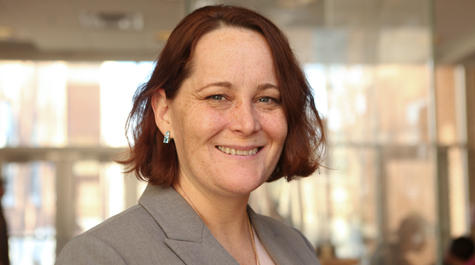At AAAS: Near-massless, neutrinos might open up some mighty weighty mysteries
Neutrinos very likely hold the key to understanding a number of the knottiest mysteries of the universe.
Patricia Vahle, Mansfield Professor of Physics at William & Mary, will talk on “The Quest to Understand Neutrino Masses” at the annual meeting of the American Association of the Advancement of Science in Washington, D.C.
Vahle is part of a four-scientist panel assembled by Fermi National Accelerator Laboratory addressing “Solving the Biggest Mysteries with the Tiniest Particles.” The session is scheduled for Friday, Feb. 15 from 10-11:30 a.m.
Neutrinos are one of the most abundant particles in the universe, Vahle said. And because of their interesting properties, physicists look to a fuller understanding of neutrinos to help unravel those mysteries mentioned in the AAAS session title.
Neutrinos are unbelievably numerous and hardly ever interact with matter. They are emitted from a number of sources, including nuclear plants and the Big Bang.
“The sun,” she continued. “Every star makes neutrinos through fusion reactions. Once those stars die and go supernova, they produce tremendous numbers of neutrinos.”
Vahle added that the neutrinos get out of the core of a supernova more quickly than the radiation does. “It also isn’t as affected by the matter they encounter, so neutrinos could tell you interesting things about how supernovas collapse and evolve after the collapse.”
Another prolific source of neutrinos are cosmic-ray interactions in the atmosphere. “There are neutrinos raining down on us all the time,” she said.
“Usually at this point, I point out that neutrinos are a product of natural radioactive decay,” Vahle added. “You may have a little neutrino generator sitting on the kitchen counter: Bananas. They have a little radioactive potassium in them.”
Vahle is one of a number of William & Mary physicists that work on neutrino experiments based at Fermilab, where scientist make their own neutrinos.
“We make beams of neutrinos,” she explained. “These are well-controlled, well-understood sources that we can use in our studies.”
Last year, Vahle was named co-spokesperson for the NOvA experiment, a collaboration that involves more than 200 scientists representing nearly 50 institutions. NOvA sends a beam of neutrinos from Fermilab in Batavia, Illinois, to a detector in Northern Minnesota.
NOvA and other experiments have revealed a number of things about the particles, Vahle said. Scientists have found, for instance, that neutrinos come in three “flavor” states: electron, muon and tau. There are three mass states as well: m1, m2 and m3.
The three flavor states don’t stay the same. They oscillate — change flavor — mid-flight. The understanding of mass and flavor are intertwined. Vahle explains that there is a connection, but not a direct correlation, between the three masses and the three flavors.
“The neutrino we call the electron neutrino is actually made up of a little bit of the mass 1 state, mass 2 state and the mass 3 state. So, each one of the flavor states is a different combination of the mass states,” she said.
Neutrinos, and especially the relationships among neutrino flavors and masses, seem impossibly complicated until you look at the phenomena through the mathematical lens of quantum mechanics, Vahle said.
“Quantum mechanics is not really complicated, but it’s very non-intuitive,” she said. “It’s hard to get your head around, but the math is really simple and elegant.”
She added that neutrino oscillation is, at its heart, a very basic, textbook example of a quantum mechanical system and one that plays out over long distances, such as the 500-mile stretch between NOvA’s beam source outside Chicago and the far detector deep below the earth in Minnesota.
“It’s a neat thing to study because it’s a quantum phenomenon that develops over a macroscopic distance,” she said. “Usually, when you study quantum mechanics, it’s on a scale so small that it will never affect your everyday life.”
The working theory among physicists until 1998 was that neutrinos had no mass. The idea of a particle with no mass may seem like an oxymoron to anyone but a physicist. But photons and gluons also are massless particles.
Vahle explained that scientists working to complete the Standard Model, the inventory-in-progress of the particles and interactions that make up the universe, hadn’t observed neutrino mass in experiments up until the Super-Kamiokande experiment in Japan presented evidence that the neutrino had mass greater than zero.
Vahle and her fellow panelists will discuss progress in the 20 years since Super-Kamiokande as well as the next step toward resolving the mystery of neutrino masses.
“I will be concentrating on the differences in the masses. That’s my specialty. But I’ll also be talking about how you measure the absolute mass of a neutrino and the prospects for doing that,” she said. “There is an experiment called KATRIN that will turn on soon. We hope it will shed new light on the absolute neutrino mass.”
 Skip to main content
Skip to main content

